automobile

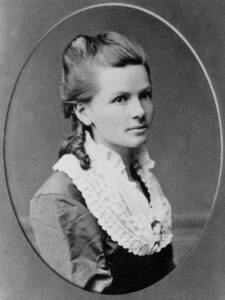 In the United States, at least, many of us equate the first car to Henry Ford, but in reality, that is not the case. In fact, the first car wasn’t built in the United States at all. Henry Ford made great strides in the automobile industry, to be sure, but he didn’t start it all. That honor goes to two European engineers, Karl Benz and Emile Levassor. Benz and Levassor created the first automobile in the 19th Century.
In the United States, at least, many of us equate the first car to Henry Ford, but in reality, that is not the case. In fact, the first car wasn’t built in the United States at all. Henry Ford made great strides in the automobile industry, to be sure, but he didn’t start it all. That honor goes to two European engineers, Karl Benz and Emile Levassor. Benz and Levassor created the first automobile in the 19th Century.
Benz patented the first automobile in 1886. It was called the Benz Patent-Motorwagen (meaning “patent motorcar”), and it was actually built in 1885 by Karl Benz. This one is widely regarded as the world’s first production automobile…meaning a self-propelled vehicle for carrying people. I suppose that at the time, the vehicle was considered expensive with an original cost of 600 imperial German marks, which equates to approximately 150 US dollars, or about $4,321 in 2020. Karl Benz applied on January 29, 1886, and the vehicle was awarded the German patent number 37435. Following official procedures, the date of the application  became the patent date for the invention once the patent was granted, which occurred in November of that year. Benz actually unveiled his invention to the public on July 3, 1886, on the Ringstrasse in Mannheim. About 25 Patent-Motorwagen were built between 1886 and 1893. The car is currently being maintained by Mercedes-Benz Classic.
became the patent date for the invention once the patent was granted, which occurred in November of that year. Benz actually unveiled his invention to the public on July 3, 1886, on the Ringstrasse in Mannheim. About 25 Patent-Motorwagen were built between 1886 and 1893. The car is currently being maintained by Mercedes-Benz Classic.
The “car” was really a glorified tricycle…with a motor, of course. It had three wheels that looked much like bicycle wheels. It would not be the kind of car that a person would want to ride in during the winter months. There is no top on the vehicle at all, and of course, no heat. It’s just you and the elements. Still, you could get where you were going faster, at least for that time in history. So, you didn’t have to be out in the elements as long. The car was a little primitive, but it did set a record or two. On August 5, 1888, Karl Benz wife, Bertha was the first person to drive an internal-combustion-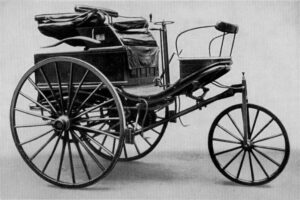
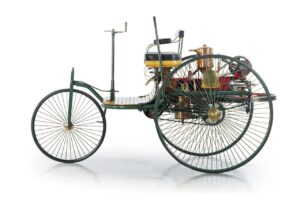 engined automobile over a long distance…about 65 miles. Long for the time, I guess. She was actually field testing the Benz Patent-Motorwagen. They were working on inventing a brake lining and solving several practical issues during the journey. The car did well, and in doing so, she brought the Patent-Motorwagen some worldwide attention and got the company its first sales. It was an amazing day.
engined automobile over a long distance…about 65 miles. Long for the time, I guess. She was actually field testing the Benz Patent-Motorwagen. They were working on inventing a brake lining and solving several practical issues during the journey. The car did well, and in doing so, she brought the Patent-Motorwagen some worldwide attention and got the company its first sales. It was an amazing day.

 When my oldest daughter, Corrie Petersen was born, it was one of the happiest days of her great grandmother, Nettie Knox’s life, because her first great grandchild had been born on her birthday. It’s called “birthday twins” and it’s been the coolest thing for both Grandma Knox and Corrie. When Corrie was little, and indeed until grandma passed away when she was just a month past 82, and Corrie was just a month past 15, they celebrated their birthdays together. It was so important to both of them. Their bond was a very special one and lasted for the rest of Grandma’s life…and beyond. I know that with Grandma in Heaven now, Corrie feels sad sometimes, and her birthday is just a little bittersweet, but I hope Corrie knows just how proud Grandma always was of her.
When my oldest daughter, Corrie Petersen was born, it was one of the happiest days of her great grandmother, Nettie Knox’s life, because her first great grandchild had been born on her birthday. It’s called “birthday twins” and it’s been the coolest thing for both Grandma Knox and Corrie. When Corrie was little, and indeed until grandma passed away when she was just a month past 82, and Corrie was just a month past 15, they celebrated their birthdays together. It was so important to both of them. Their bond was a very special one and lasted for the rest of Grandma’s life…and beyond. I know that with Grandma in Heaven now, Corrie feels sad sometimes, and her birthday is just a little bittersweet, but I hope Corrie knows just how proud Grandma always was of her.
These past few years…the craziest ones Corrie has ever spent, have brought her to a new career, and I have been thinking about just how proud Grandma would have been of her birthday twin. She was always proud of Corrie, and it didn’t matter what kind of work she did, but the hard work to get where she is now…that’s what Grandma would have been proud of. Grandma was a hard-working woman in her younger years, but most of it was housework and raising her children. These days many women work outside the home. It is more unusual for someone to be a stay-at-home mom. The opportunities for Grandma were different than those available to Corrie. Then again, the things she did, that Corrie will never do, are many as well.
Grandma was born on June 30, 1908. Life was quite different then. The automobile was invented, but still very new, and it was not unusual to see horses and buggies on the same streets as the cars. These days, people are fighting for a minimum wage of $15.00 an hour, but back then, the average factory worker made around $12.00 a week!! Of course, the prices of things were much less then too, but it does show a markedly different 
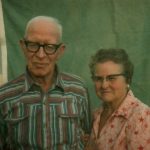 world when Grandma was born, than the one we live in now. When you think about it, if we cut the price of everything and then cut the wages, we would be in the same place we are right now. Grandma Knox saw a lot of changes during her time here on Earth, and I’m sure some things seemed as strange as the first laptop did to us. Progress is a big deal in any era. Still, for Grandma, little could top that fact that her first great grandchild had arrives on her birthday. She considered it the best gift ever. Today marks the 115th anniversary of Grandma Knox’s birth!! Happy birthday in Heaven, Grandma. We love and miss you very much.
world when Grandma was born, than the one we live in now. When you think about it, if we cut the price of everything and then cut the wages, we would be in the same place we are right now. Grandma Knox saw a lot of changes during her time here on Earth, and I’m sure some things seemed as strange as the first laptop did to us. Progress is a big deal in any era. Still, for Grandma, little could top that fact that her first great grandchild had arrives on her birthday. She considered it the best gift ever. Today marks the 115th anniversary of Grandma Knox’s birth!! Happy birthday in Heaven, Grandma. We love and miss you very much.

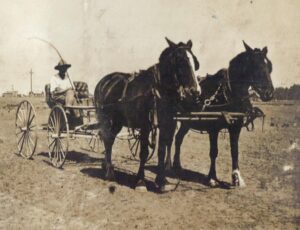 Road rage is a common expression these days. In fact, you would have to be living under a rock not to know what road rage is. Most of us think that road rage is something that has come about as there are more and more vehicles on the road; as well as the fact that so many people are so busy, and stress is an ever-present part of life. While I personally believe that road rage has really gotten out of hand, I suppose that it has actually taken centuries…yes, centuries to get there, but it really has gotten way out of control.
Road rage is a common expression these days. In fact, you would have to be living under a rock not to know what road rage is. Most of us think that road rage is something that has come about as there are more and more vehicles on the road; as well as the fact that so many people are so busy, and stress is an ever-present part of life. While I personally believe that road rage has really gotten out of hand, I suppose that it has actually taken centuries…yes, centuries to get there, but it really has gotten way out of control.
In fact, road rage didn’t even begin with the invention of the automobile. There are instances of “road rage” even as far back as the days of horses and chariots, as well as occurrences during the horse and buggy days, not to mention the days of bicycles. It seems that people have always argued over the right-of-way. The reality is that people have always argued over rights in general. For some people, when they get in the driver’s seat, many people check all sense of calmness at the entrance to the vehicle. These same people can’t seem to control their tempers and look beyond the mistake the other driver might have made, to notice that the offending driver might have been having a bad day.
Don’t get me wrong, I have been guilty of road rage too, and looking back I am pretty ashamed of myself for it. I have also been “guilty” of anti-road rage too, and I always walk away feeling awful. I far prefer to see the smile on the face of the offending person, who’s heart has been racing in anticipation of the screaming rage that is coming their way…the screaming rage that doesn’t come. Then, when they see the smile on my face telling them that all is well, and they aren’t going to get yelled at, their face floods with relief. I’m telling you, there is no better feeling behind the wheel than that.
In the instance I am referring to, I was at a traffic light waiting for my turn to go. The light changed to green, 
 and I prepared to go, when a car ran the red light. As she started into the intersection, her eyes were a big as saucers. It was my chance to change the situation. I smiled and waved her through the light. Shocked, she smiled back, and I can tell you that we both went to work that day feeling a lot better than we had just moments before. If only everybody just took a breath and smiled, instead of raging.
and I prepared to go, when a car ran the red light. As she started into the intersection, her eyes were a big as saucers. It was my chance to change the situation. I smiled and waved her through the light. Shocked, she smiled back, and I can tell you that we both went to work that day feeling a lot better than we had just moments before. If only everybody just took a breath and smiled, instead of raging.

 My sister-in-law, Brenda Schulenberg is a woman who is determined to accomplish her goals and dreams. She doesn’t let anything get in the way of getting her daily steps in, whether it is bicycling steps or foot steps, she reaches her goal of 25,000 steps a day…every day. If that means she gets up at 4:00 am to get to work at 8:00 am, then she does. Nothing gets in the way of her step count. At night, if she has been traveling during the day, and is a little behind in her steps, she simply doesn’t sit down until she finishes the steps. That means walking around her house for as long as it takes. Any place can be a trail, as long as you have room to walk around. Trails aren’t always outside, and Brenda utilizes any space necessary to complete her daily steps.
My sister-in-law, Brenda Schulenberg is a woman who is determined to accomplish her goals and dreams. She doesn’t let anything get in the way of getting her daily steps in, whether it is bicycling steps or foot steps, she reaches her goal of 25,000 steps a day…every day. If that means she gets up at 4:00 am to get to work at 8:00 am, then she does. Nothing gets in the way of her step count. At night, if she has been traveling during the day, and is a little behind in her steps, she simply doesn’t sit down until she finishes the steps. That means walking around her house for as long as it takes. Any place can be a trail, as long as you have room to walk around. Trails aren’t always outside, and Brenda utilizes any space necessary to complete her daily steps.
Brenda spent much of her life overweight and really unhealthy, and while most people wouldn’t want me to talk about that part of their lives, Brenda uses that part of her life, and the transition she has made to be an inspiration to others. She has set another goal for herself…to reach out to other people who are where she was…to let them know that it is never too late to change your life for the better. Getting healthy and fit is just a step away. Yes, it will take many steps, but the first step is the most important, because without the first step, you remain an overweight, unhealthy, couch potato. Of course, that first step…must be taken every day, if you are going to have to succeed. Most people when they get to that place, where their weight is out of control, and they have become unhealthy, decide that because of this health problem or that health problem, it is simply impossible for them to lose weight and become healthy again. Brenda is proof positive that they can. All it takes is much determination and that first step.
These days, Brenda enjoys things like traveling…by plane, train, or automobile. These are things she really couldn’t do before she lost the weight. She was so limited. Now she travels to different areas around Wyoming 
 and Colorado to speak to others about her story. Sometimes, all it takes to get someone started on the road to better health, is to see that someone else made it. Getting started is so hard, especially when you feel like you will never make it, but when you see someone like Brenda, who has turned her whole life around, you begin to feel like you can do it too. And that is what inspires Brenda…helping other people to succeed. Today is Brenda’s birthday. Happy birthday Brenda!! Have a great day!! We love you!!
and Colorado to speak to others about her story. Sometimes, all it takes to get someone started on the road to better health, is to see that someone else made it. Getting started is so hard, especially when you feel like you will never make it, but when you see someone like Brenda, who has turned her whole life around, you begin to feel like you can do it too. And that is what inspires Brenda…helping other people to succeed. Today is Brenda’s birthday. Happy birthday Brenda!! Have a great day!! We love you!!
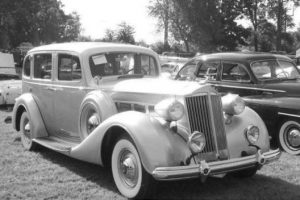 These days, driving our cars everywhere we go, there are certain amenities in our cars that we take for granted, but that in reality, we just couldn’t live without. One of those amenities is the automobile air conditioner. Summers would be just miserable without air conditioning in the car. While a company in New York City first offered installation of air conditioning for cars in 1933. Most of their customers operated limousines and luxury cars. I don’t suppose too many people could afford to add that to their car. Then, in 1939, Packard became the first automobile manufacturer to offer an air conditioning unit in its cars. I’m sure that everyone who could afford to buy a car that year, was really excited about the possibilities.
These days, driving our cars everywhere we go, there are certain amenities in our cars that we take for granted, but that in reality, we just couldn’t live without. One of those amenities is the automobile air conditioner. Summers would be just miserable without air conditioning in the car. While a company in New York City first offered installation of air conditioning for cars in 1933. Most of their customers operated limousines and luxury cars. I don’t suppose too many people could afford to add that to their car. Then, in 1939, Packard became the first automobile manufacturer to offer an air conditioning unit in its cars. I’m sure that everyone who could afford to buy a car that year, was really excited about the possibilities.
The cars were manufactured by Bishop and Co, of Cleveland, Ohio. The “Bishop and Babcock Weather Conditioner” also incorporated a heater. This looked like a perfect car. Cars ordered with the new “Weather Conditioner” were shipped from Packard’s East Grand Boulevard facility to the B&B factory where the conversion was performed. Once complete, the car was shipped to a local dealer where the customer would take delivery. There were some drawbacks, however. When you think about automobile air conditioning and heat, you immediately think what drawback could there be?
Packard fully warranted and supported this conversion, and marketed it well. However, it was not commercially successful for a number of reasons. The main evaporator and blower system took up half of the trunk space. That problem was alleviated as trunks became larger in the post-war period. The system became outdated by more efficient systems in the post-war years. The original system had no temperature thermostat or shut-off  mechanism other than switching the blower off, and even with the switch off, cold air would still sometimes enter the car with any movement as the drive belt was continuously connected to the compressor. Systems designed later would use electrically operated clutches to remedy this problem. The several feet of plumbing going back and forth between the engine compartment and trunk proved unreliable in service. Probably the biggest deterrent was the price, at $274, which would be over $4,692.12 in 2014 US dollars today, it was not affordable to most people in post-depression/pre-war America, but I doubt if the fact that you had to turn off the engine and get out of the car to flip the switch, located in the trunk made it impractical for the most part, and because it also had to be turned off the same way,and with no adjustment, it was something you had to do often. The option was discontinued after 1941. Of course, as you all know, while this version was discontinued in 1941, the air conditioner was not, because we all have a much more efficient version in our automobiles today.
mechanism other than switching the blower off, and even with the switch off, cold air would still sometimes enter the car with any movement as the drive belt was continuously connected to the compressor. Systems designed later would use electrically operated clutches to remedy this problem. The several feet of plumbing going back and forth between the engine compartment and trunk proved unreliable in service. Probably the biggest deterrent was the price, at $274, which would be over $4,692.12 in 2014 US dollars today, it was not affordable to most people in post-depression/pre-war America, but I doubt if the fact that you had to turn off the engine and get out of the car to flip the switch, located in the trunk made it impractical for the most part, and because it also had to be turned off the same way,and with no adjustment, it was something you had to do often. The option was discontinued after 1941. Of course, as you all know, while this version was discontinued in 1941, the air conditioner was not, because we all have a much more efficient version in our automobiles today.
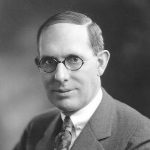 When the automobile first came out, driving them safely wasn’t the only difficulty. The early years of the automobile, found drivers using iron hand cranks to start the internal combustion process that powered the engines on their cars. Getting them started took great hand and arm strength, and the system was not without certain risks. Drivers who forgot to turn the ignition off before turning the crank, could be surprised when the car backfired or rolled forward. You may not know it, but at that time most vehicles had no brakes. Clearly a better system was needed, and in 1911 Cadillac head Henry M Leland gave Charles F Kettering the task of developing one. Kettering was the co-founder of Dayton Engineering Laboratories Company (DELCO) in Dayton, Ohio.
When the automobile first came out, driving them safely wasn’t the only difficulty. The early years of the automobile, found drivers using iron hand cranks to start the internal combustion process that powered the engines on their cars. Getting them started took great hand and arm strength, and the system was not without certain risks. Drivers who forgot to turn the ignition off before turning the crank, could be surprised when the car backfired or rolled forward. You may not know it, but at that time most vehicles had no brakes. Clearly a better system was needed, and in 1911 Cadillac head Henry M Leland gave Charles F Kettering the task of developing one. Kettering was the co-founder of Dayton Engineering Laboratories Company (DELCO) in Dayton, Ohio.
Before founding DELCO with his partner Edward Deeds in 1909, Kettering worked at the National Cash Register Company. While there, he helped develop the first electric cash register. I’m sure that was what called attention to him when Leland was looking for the right inventor for his project. Kettering drew on his experience with the cash register, when approaching his work with automobiles. The new invention wasn’t that big a leap from the cash register either. Just as the touch of a button had started a motor that opened the drawer of the cash register, Kettering would eventually use a key to turn on his self-starting motor. The self-starter was introduced in the 1912 Cadillac, patented by Kettering in 1915, when he was issued U.S. Patent No. 1,150,523 for his “engine-starting device,” the first electric ignition device for automobiles, on August 17, 1915.
The device worked so well that by the 1920s, it would come standard on nearly every new automobile. The device made cars easier and safer to operate, especially for women. The new self-starting engine was a huge hit, and caused a big jump in sales. The new engine was responsible for the fast-growing automobile culture in America. United Motors Corporation, which would become General Motors, bought DELCO in 1916. Kettering was the vice president and director of research at GM from 1920 to 1947. The self-starting engine wasn’t the only invention Kettering headed-up. Other important auto-related innovations developed during Kettering’s  tenure were quick-drying automotive paint, spark plugs, leaded gasoline, shock absorbers, the automatic transmission, four-wheel brakes, the diesel engine and safety glass. He helped develop the refrigerant Freon, used in refrigerators and air conditioners, and the Kettering home in Dayton was the first in the country to be air-conditioned. In the realm of medicine, Kettering created a treatment for venereal disease and an incubator for premature infants, and in 1945 he and longtime General Motors head Alfred P Sloan established the Sloan-Kettering Institute for Cancer Research in New York City. Charles F Kettering died in 1958, having made great contributions toward the improvement of many lives.
tenure were quick-drying automotive paint, spark plugs, leaded gasoline, shock absorbers, the automatic transmission, four-wheel brakes, the diesel engine and safety glass. He helped develop the refrigerant Freon, used in refrigerators and air conditioners, and the Kettering home in Dayton was the first in the country to be air-conditioned. In the realm of medicine, Kettering created a treatment for venereal disease and an incubator for premature infants, and in 1945 he and longtime General Motors head Alfred P Sloan established the Sloan-Kettering Institute for Cancer Research in New York City. Charles F Kettering died in 1958, having made great contributions toward the improvement of many lives.
 When a body of water stands between two places that people need to go, there are a few options to solve the dilemma…a bridge, a road around, or as was the case of a way across the Detroit River, a tunnel. With a river, you can’t really go around, so often it’s a bridge, but in this case there was a great deal of opposition to a bridge over the river. Since the beginning of the 19th century, Detroiters and Windsorians had been trying to find a way to move people and goods back and forth across the Detroit River. For decades, railroad interests proposed tunnels and bridges galore, but powerful advocates of marine shipping always managed to block those projects, because they did not want to lose business to faster and more capacious trains. Plans for bridges were particularly troubling to those shippers, since just one low-hanging bridge had the potential to keep high-masted sailing vessels off the river altogether.
When a body of water stands between two places that people need to go, there are a few options to solve the dilemma…a bridge, a road around, or as was the case of a way across the Detroit River, a tunnel. With a river, you can’t really go around, so often it’s a bridge, but in this case there was a great deal of opposition to a bridge over the river. Since the beginning of the 19th century, Detroiters and Windsorians had been trying to find a way to move people and goods back and forth across the Detroit River. For decades, railroad interests proposed tunnels and bridges galore, but powerful advocates of marine shipping always managed to block those projects, because they did not want to lose business to faster and more capacious trains. Plans for bridges were particularly troubling to those shippers, since just one low-hanging bridge had the potential to keep high-masted sailing vessels off the river altogether.
In 1871, the region’s railroads finally won permission to build a trans-national tunnel, and workers began to dig into the river at the foot of Detroit’s San Antoine Street. They were forced to abandon the project just 135 feet  under the river, however, when they struck a pocket of sulfurous gas that made workers so ill that none could be persuaded to return. Likewise, in 1879, another tunnel had to be abandoned when it ran right into some unexpectedly difficult to excavate limestone under the river. The first successful Michigan to Canada tunnel project finally opened in 1891. It was the 6,000 foot long Grand Trunk Railway Tunnel at Port Huron.
under the river, however, when they struck a pocket of sulfurous gas that made workers so ill that none could be persuaded to return. Likewise, in 1879, another tunnel had to be abandoned when it ran right into some unexpectedly difficult to excavate limestone under the river. The first successful Michigan to Canada tunnel project finally opened in 1891. It was the 6,000 foot long Grand Trunk Railway Tunnel at Port Huron.
Soon enough, it was clear to most people on both sides of the border that they needed to build some sort of structure for transporting automobiles across the river too. In June 1919, the mayors of Detroit and Windsor decided to build a city to city tunnel that would serve as a memorial to the American and Canadian soldiers who had died in World War I. Even after advocates of the under-construction Ambassador Bridge tried to frighten away the tunnel’s backers by spreading rumors about the danger of subterranean carbon monoxide poisoning, the tunnel boosters were undeterred. One said, they were “inspired by God to have this tunnel built.” Construction began in 1928. First, barges were used to dredge a 2,454 foot long trench across the river. Then workers sank nine 8,000 ton steel and concrete tubes into the trench and welded them together. Finally, an  elaborate ventilation system was built to make sure that the air in the tunnel safe to breathe.
elaborate ventilation system was built to make sure that the air in the tunnel safe to breathe.
On Nov 1, 1930, President Herbert Hoover turned a telegraphic Golden Key in the White House to mark the opening of the 5,160 foot long Detroit-Windsor Tunnel between the United States city of Detroit, Michigan, and the Canadian city of Windsor, Ontario. The tunnel opened to regular traffic on November 3, 1930. The first passenger car it carried was a 1929 Studebaker. In the first nine weeks it was open, nearly 200,000 cars passed through the Detroit-Windsor Tunnel. Today, about 9 million vehicles use the tunnel each year.
 These days, so many things are automated, that we hardly know how to work in an environment that requires us to hand build everything. Machines often make most of the things we buy, but it wasn’t always so. In the beginning of the automobile age, cars had to be put together by hand, making it a very slow process. If you are going to sell mass quantities of something, you have to be able to mass produce it. Selling mass quantities of his now famous, Model T, was exactly what Henry Ford wanted to do. So he came up with a way to move the vehicles from one worker to another. Each worker had a specific part they were to place, before the vehicle moved on down the line. Ford’s dream was to make the automobile available to everyone, not just the rich, who could afford to order the new fangled machines. Of course, most people those days didn’t really think that the automobile would ever amount to much, but as we all know, they were very wrong. The automobile has become an absolute necessity for most people…except maybe some in the bigger cities, where owning a car isn’t really feasible because of parking issues and heavy traffic.
These days, so many things are automated, that we hardly know how to work in an environment that requires us to hand build everything. Machines often make most of the things we buy, but it wasn’t always so. In the beginning of the automobile age, cars had to be put together by hand, making it a very slow process. If you are going to sell mass quantities of something, you have to be able to mass produce it. Selling mass quantities of his now famous, Model T, was exactly what Henry Ford wanted to do. So he came up with a way to move the vehicles from one worker to another. Each worker had a specific part they were to place, before the vehicle moved on down the line. Ford’s dream was to make the automobile available to everyone, not just the rich, who could afford to order the new fangled machines. Of course, most people those days didn’t really think that the automobile would ever amount to much, but as we all know, they were very wrong. The automobile has become an absolute necessity for most people…except maybe some in the bigger cities, where owning a car isn’t really feasible because of parking issues and heavy traffic.
On this day, October 7, 1913, Henry Ford’s entire Highland Park, Michigan automobile factory started running on a continuously moving assembly line where the chassis, which is the automobile’s frame, was assembled using a state of the art, revolutionary industrial technique. A motor and rope pulled the chassis past workers and parts on the factory floor, cutting the man hours required to complete one “Model T” from 12-1/2 hours to six. Within a year, improvements in the assembly line reduced the time required to 93 man minutes…to build a car!! That is just amazing to me. The increase in productivity brought about by Ford’s use of the moving assembly line allowed him to drastically reduce the cost of the Model T. Ford’s goal was to make the car affordable to ordinary consumers. This new process allowed him to realize that goal, and before long, everyone had an automobile.
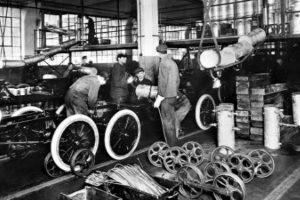
Since the days of Ford’s antiquated assembly line, automation has vastly improved. These days machines can do so much more that their human counterparts. Of course, that has eliminated more than just a few jobs, but as people have learned to run that equipment, new jobs have opened up. In this world, time doesn’t stand still, and progress waits for no man. You have to learn the new skills as they come along so that you can keep up in this fast paced automated world. Assembly lines have come a long way since those old days, and it’s a good thing, because the automobile is now in very high demand around the world, and people won’t wait very long to get one.
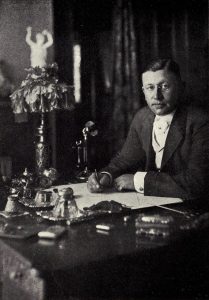 I think that most of us have engaged in a wager or two…probably more in fact. For most of us gambling brings little or no gain, and instead, usually loss. That is what it would bring for Horatio Nelson Jackson, as he, to his own folly, accepted a $50.00 bar bet, back in 1903. At that time, there were roads for the cars that were coming out, but they were…well, rough, and that’s an understatement. Unpaved dirt roads are notoriously dusty, rutted, and muddy in the rain. Most people, at that time, considered the automobile a passing novelty, too unreliable to survive a trip across America, but Jackson argued that they were wrong. As often happens in these barroom discussions, someone called Jackson out on his theory. He bet Jackson that he could not drive a car from San Francisco, California to New York City, New York in 90 days. Jackson accepted the challenge.
I think that most of us have engaged in a wager or two…probably more in fact. For most of us gambling brings little or no gain, and instead, usually loss. That is what it would bring for Horatio Nelson Jackson, as he, to his own folly, accepted a $50.00 bar bet, back in 1903. At that time, there were roads for the cars that were coming out, but they were…well, rough, and that’s an understatement. Unpaved dirt roads are notoriously dusty, rutted, and muddy in the rain. Most people, at that time, considered the automobile a passing novelty, too unreliable to survive a trip across America, but Jackson argued that they were wrong. As often happens in these barroom discussions, someone called Jackson out on his theory. He bet Jackson that he could not drive a car from San Francisco, California to New York City, New York in 90 days. Jackson accepted the challenge.
Jackson asked Sewall Crocker to accompany him on the trip. Crocker was a 22 year old former bicycle racer and a gasoline engine mechanic. Jackson was a doctor who had given up his medical practice after a bout of tuberculosis. At this point, he was looking for adventure. Crocker suggested that the former physician purchase a used 20 horsepower Winton touring car for the treacherous journey, so Jackson did, and named it the “Vermont.” Then on May 23, 1903, the two men hopped in and headed east. They had packed sleeping bags, food, and other camping supplies. Previous cross country trips had all ended in failure, and it was likely that this one would suffer a similar fate, but this was to be the first successful cross country road trip.
Horatio Jackson had little driving experience, and no mechanical knowledge, but he had his wife’s inherited fortune, and apparently that was burning a hole in he pockets. The roads he was to be on had no road signs, 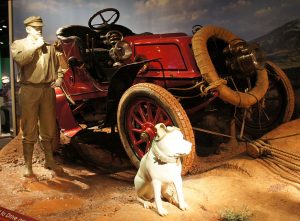 there was no GPS, and more importantly, there were no gas stations…plus the fact that automobiles were prone to breakdowns. The Vermont was no different, the first pit stop was just 15 miles into the trip when they blew a tire. There would be many others. Nevertheless, Jackson would win his bar bet and the $50.00 when he rolled into New York City. The mud caked Vermont, crawled down Manhattan’s deserted Fifth Avenue at 4:30 am on Sunday, July 26. The approximately 4,500 mile journey had taken 63 days, 12 hours and 30 minutes, amazing considering all the problems. So what then was the road trip folly? Just this…Jackson had won his wager with nearly a month to spare, but it cost him $8,000 in the process. I guess he could always say he made the trip.
there was no GPS, and more importantly, there were no gas stations…plus the fact that automobiles were prone to breakdowns. The Vermont was no different, the first pit stop was just 15 miles into the trip when they blew a tire. There would be many others. Nevertheless, Jackson would win his bar bet and the $50.00 when he rolled into New York City. The mud caked Vermont, crawled down Manhattan’s deserted Fifth Avenue at 4:30 am on Sunday, July 26. The approximately 4,500 mile journey had taken 63 days, 12 hours and 30 minutes, amazing considering all the problems. So what then was the road trip folly? Just this…Jackson had won his wager with nearly a month to spare, but it cost him $8,000 in the process. I guess he could always say he made the trip.
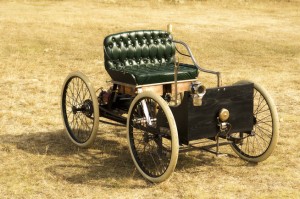 Henry Ford has long been credited for building the first automobile, but what I find interesting and even a little bit funny, is the fact that in reality, that first vehicle, introduced on this day, June 4, 1896, was called a Quadricycle, and in reality was far more like the modern day 4 wheeler ATV than it was an automobile. When we think of an automobile, even the early models, we think of a vehicle with a top over it, or really an automobile body over it. Such was not the case with Ford’s first design. He was more interested in making a vehicle that ran…and ran fast…than in a way to protect the passengers from the elements. I suppose that since people were used to riding in wagons or carriages, having a cover over the Quadricycle wasn’t the most important thing on the wish list. Of course, when it came to capabilities, the Quadricycle was nothing like the modern day ATV, but then the original cars were not capable of going as fast or as far as the modern day automobiles either.
Henry Ford has long been credited for building the first automobile, but what I find interesting and even a little bit funny, is the fact that in reality, that first vehicle, introduced on this day, June 4, 1896, was called a Quadricycle, and in reality was far more like the modern day 4 wheeler ATV than it was an automobile. When we think of an automobile, even the early models, we think of a vehicle with a top over it, or really an automobile body over it. Such was not the case with Ford’s first design. He was more interested in making a vehicle that ran…and ran fast…than in a way to protect the passengers from the elements. I suppose that since people were used to riding in wagons or carriages, having a cover over the Quadricycle wasn’t the most important thing on the wish list. Of course, when it came to capabilities, the Quadricycle was nothing like the modern day ATV, but then the original cars were not capable of going as fast or as far as the modern day automobiles either.
Henry Ford didn’t start out as an inventor, but was actually working as the chief engineer for the main plant of the Edison Illuminating Company when he began working on the Quadricycle. He was on call at all hours, because they had to ensure that Detroit had electrical service 24 hours a day. His flexible schedule gave Ford the freedom needed to experiment with his pet project, which was building a horseless carriage with a gasoline powered engine. Ford had seen an article on the subject gasoline powered motors in a November 1895 issue of American Machinist magazine, and his obsession with the gasoline engine was born. Then, the following March, another Detroit engineer named Charles King introduced his hand built wooden vehicle with a four cylinder engine, beating Ford out by about three months. His vehicle was able to travel up to five miles per hour, fueling Ford’s desire to build a lighter and faster gasoline powered vehicle.
As great as Ford was at building his Quadricycle, which would travel at speeds of about 20 miles per hour, it is doubtful that Ford could have ever been hailed as a great designer of garages. As he and his crew went to push the Quadricycle out of the back yard shed they had built it in, they discovered that it was too wide to fit through the door. Not willing to wait another minute, Ford grabbed an axe, and smashed the brick wall away to allow the Quadricycle to be pushed out. Then as a friend rode his bicycle down the street to warn the people of the vehicle that was to follow, Ford drive his Quadricycle for the first time. I find it odd that while Charles King actually built that first vehicle, he was never really credited with doing so, and Ford went on to build many of them, and as we all know, to become quite famous doing so.

